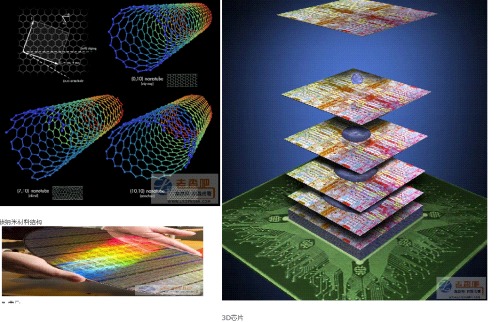 In recent days, news of IBM, Samsung, and other 3D chips have appeared in an endless stream. Transistors have become increasingly dense on integrated circuit chips. When silicon transistors reach their limits in size, in addition to introducing 3D improvements in the structure, in order to improve the performance of the chips, It is also important to find another material that breaks through the silicon crystal limit. A few days ago Intel announced that 14nm silicon crystal chips have been tested in the experiment, and IBM developed newer transistors smaller than 10nm, using carbon nanomaterials.
In recent days, news of IBM, Samsung, and other 3D chips have appeared in an endless stream. Transistors have become increasingly dense on integrated circuit chips. When silicon transistors reach their limits in size, in addition to introducing 3D improvements in the structure, in order to improve the performance of the chips, It is also important to find another material that breaks through the silicon crystal limit. A few days ago Intel announced that 14nm silicon crystal chips have been tested in the experiment, and IBM developed newer transistors smaller than 10nm, using carbon nanomaterials. At an IEEE conference on electronic devices, IBM scientists demonstrated to the world the first transistors smaller than 10nm. Unlike current silicon transistors, they use carbon nanomaterials. In contrast, Intel's 14nm silicon transistors pale in size.
The industry has a well-known Moore's Law on the number of transistors in integrated circuits. Moore's Law states that when the price does not change, the number of transistors that can be accommodated on an integrated circuit will double approximately every 18 months, and the performance will also double. The law was proposed by one of Intel’s founders, Moore, and has been consistent with the development of the chip over the years.
However, as the density of transistors on an integrated circuit increases, it becomes increasingly difficult to increase its density. Moore's Law will bring the size of the transistor to a physical limit.
A few days ago, on the issue of how to break through the physical limits of transistor density, various chip makers such as IBM and Samsung all turned their attention to 3D-structured chips, and they expanded the performance of the chips just like a skyscraper. Now, IBM also has answers to the search for new transistor materials.
In the more than 50 years of the development of computer processors, performance improvement and the progress of process technology are more and more obvious. However, the current design of the chip will reach a physical limit, and the product size limit affects the correctness of Moore's Law's prediction. The processor has been using silicon transistors in the process, from 65nm, 32nm, 22nm to 14nm, the more difficult it is to upgrade the process.
The world’s first transistor smaller than 10nm, demonstrated by IBM, uses a new type of carbon nanomaterial to break the 10nm mark. Also, the performance of the core transistor is superior to that of the same size silicon transistor. However, IBM also pointed out that it is still an early stage for carbon nano-transistors, but the processor chip of carbon-nano-transistors will be widely used within 10 years.
Jiangsu Shazi Electric Equipment Co., Ltd. , http://www.cnhotpoint.com
